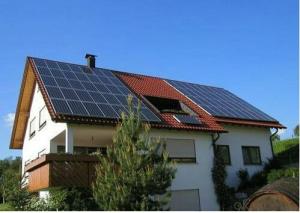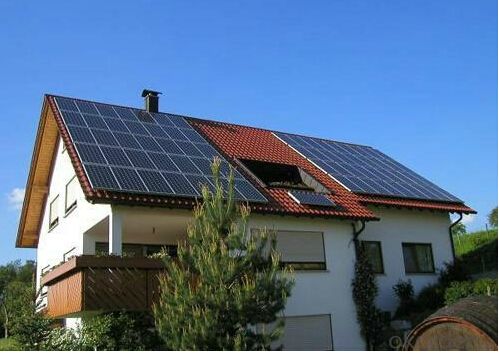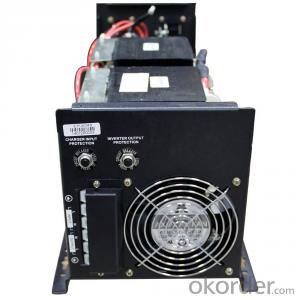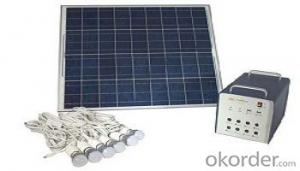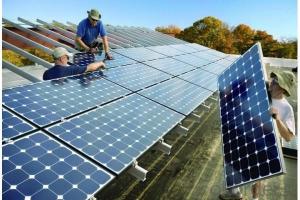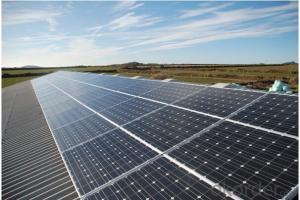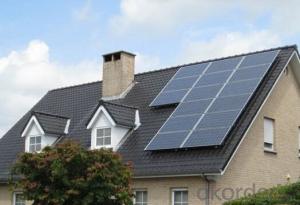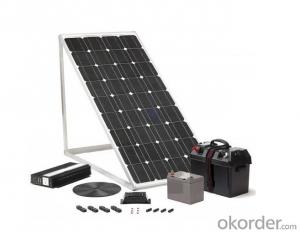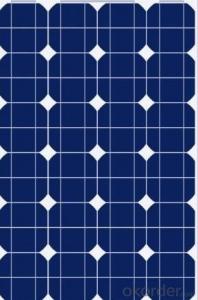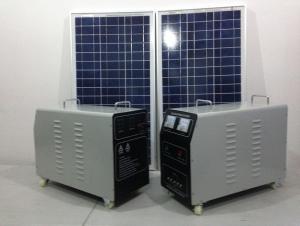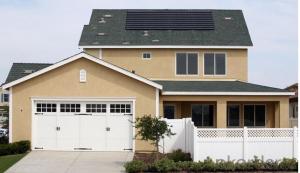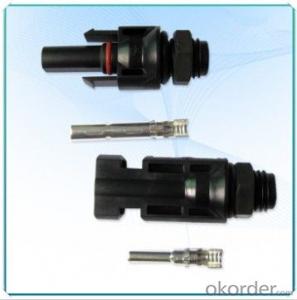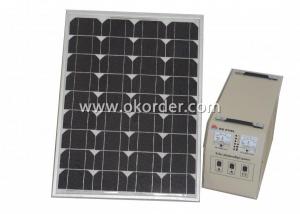Solar Energy Systems Companies' 500W Solar System Made in China
- Loading Port:
- China Main Port
- Payment Terms:
- TT OR LC
- Min Order Qty:
- -
- Supply Capability:
- -
OKorder Service Pledge
Quality Product, Order Online Tracking, Timely Delivery
OKorder Financial Service
Credit Rating, Credit Services, Credit Purchasing
You Might Also Like
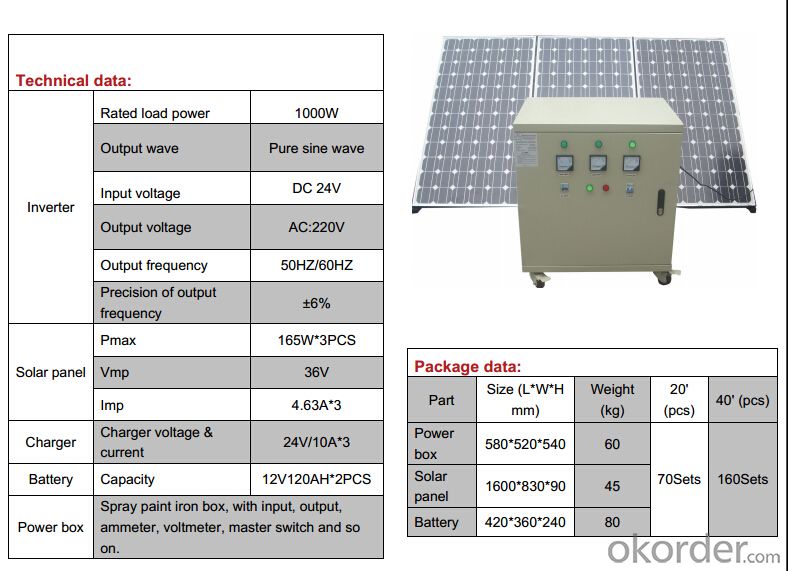
- Q: Are there any risks of electromagnetic radiation with solar energy systems?
- Yes, there are potential risks of electromagnetic radiation associated with solar energy systems. Solar energy systems use photovoltaic (PV) panels to convert sunlight into electricity. These panels generate direct current (DC) electricity, which is then converted into alternating current (AC) electricity for use in our homes and businesses. One potential source of electromagnetic radiation is the inverter, which is responsible for converting DC electricity into AC electricity. In some cases, these inverters can produce electromagnetic fields (EMFs) that may emit low-frequency radiation. While these EMFs are generally considered to be low and within acceptable limits, there is ongoing research to better understand any potential health effects associated with long-term exposure to these fields. Another potential risk is the presence of high-frequency electromagnetic radiation from radio frequency (RF) communication devices, such as wireless monitoring systems or communication modules used in solar energy systems. These devices transmit and receive signals wirelessly, and there is some concern about the potential health effects of long-term exposure to RF radiation. However, the power levels of these devices are generally low, and they are designed to comply with safety standards and regulations. It is important to note that the risks associated with electromagnetic radiation from solar energy systems are generally considered to be low compared to other sources of electromagnetic radiation in our everyday lives, such as cell phones, Wi-Fi routers, or power lines. Nonetheless, it is always recommended to follow safety guidelines provided by manufacturers and industry standards to minimize any potential risks.
- Q: What is a solar inverter and why is it necessary?
- A solar inverter is a device that converts the direct current (DC) generated by solar panels into alternating current (AC) that can be used to power household appliances and feed electricity back into the grid. It is necessary because most of our electrical devices and the grid operate on AC, while solar panels produce DC. The solar inverter ensures compatibility between the two, maximizing the efficiency and usability of solar energy.
- Q: Can solar energy systems be used to power large industrial facilities?
- Yes, solar energy systems can be used to power large industrial facilities. Advances in solar technology and the availability of large-scale solar installations make it feasible to generate significant amounts of electricity to meet the energy demands of industrial facilities. Additionally, the use of solar energy can help reduce carbon emissions and provide long-term cost savings for these facilities.
- Q: Can solar energy systems be used in remote locations without access to the grid?
- Yes, solar energy systems can be used in remote locations without access to the grid. These systems, commonly known as off-grid solar systems, can generate electricity by harnessing energy from the sun and store it in batteries for use when needed. This makes them a reliable and sustainable solution for powering remote locations where grid connectivity is not available.
- Q: Can solar energy systems be used in powering art galleries or museums?
- Yes, solar energy systems can indeed be used to power art galleries or museums. Solar panels can be installed on the rooftops or surrounding areas of these buildings to capture sunlight and convert it into electricity. This renewable energy source can provide a sustainable and cost-effective solution for powering lighting, climate control systems, and other electrical needs within art galleries and museums. Additionally, using solar energy can contribute to reducing the carbon footprint of these institutions, making them more environmentally friendly.
- Q: Can a solar energy system be used in areas with high levels of dust or sand?
- Yes, a solar energy system can still be used in areas with high levels of dust or sand. However, the efficiency of the system may be affected as the accumulation of dust or sand can reduce the amount of sunlight reaching the solar panels. Regular cleaning or maintenance may be required to ensure optimal performance of the system in such environments.
- Q: Can solar energy systems be used for emergency power backup?
- Yes, solar energy systems can be used for emergency power backup. Solar panels can generate electricity even during power outages, as long as they are connected to a battery storage system. This allows the stored energy to be used as a backup power source during emergencies or when the grid is down.
- Q: Are there any regulations or permits required for installing solar energy systems?
- Yes, there are regulations and permits required for installing solar energy systems. The specific requirements vary by location, but typically involve obtaining permits for building and electrical work, adhering to zoning and building codes, and complying with utility interconnection regulations. It is important to consult with local authorities or a professional installer to ensure compliance with all necessary regulations and obtain the required permits before installing a solar energy system.
- Q: Can solar energy systems be used in powering research farms or agricultural laboratories?
- Yes, solar energy systems can certainly be used to power research farms or agricultural laboratories. Solar panels can generate electricity which can be used to power various equipment and machinery used in these facilities, such as irrigation systems, lighting, climate control systems, and other electrical devices. By utilizing solar energy, these agricultural facilities can reduce their reliance on fossil fuels and significantly lower their operational costs while also contributing to a more sustainable and environmentally friendly approach to farming and research.
- Q: Can solar panels be integrated into building materials like windows or roofing tiles?
- Yes, solar panels can be integrated into building materials like windows or roofing tiles. These integrated solar panels, also known as building-integrated photovoltaics (BIPV), allow for the generation of electricity while being seamlessly incorporated into the design of the building. This integration not only reduces the need for separate solar panels but also enhances the aesthetics and functionality of the building by harnessing solar energy.
Send your message to us
Solar Energy Systems Companies' 500W Solar System Made in China
- Loading Port:
- China Main Port
- Payment Terms:
- TT OR LC
- Min Order Qty:
- -
- Supply Capability:
- -
OKorder Service Pledge
Quality Product, Order Online Tracking, Timely Delivery
OKorder Financial Service
Credit Rating, Credit Services, Credit Purchasing
Similar products
Hot products
Hot Searches
Related keywords
